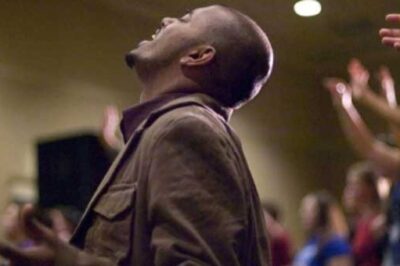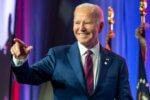Note: This article originally appeared on Charismamag.com in December 2012.
What do you get when you combine spiritual empowerment, Holy Ghost signs and miracles, and speaking in tongues with a passionate ethnicity committed to faith, family and celebration?
The answer may be nothing less than the hope for U.S. Christianity: Hispanic Spirit-empowered believers, who stand poised today to become the narrators of this century’s American faith experience.
America’s religious landscape is undergoing an unprecedented transformation as a result of the booming ethnic demographic of the Hispanic-American community. While it’s no secret among church researchers that a Pentecostal explosion south of the equator is transforming Latin American nations, many American Christians remain unaware that the same wind of the Spirit is blowing within U.S. borders, brought here or already embraced by Hispanic believers.
The measurable impact of this already exists in three of the most prominent, historic Pentecostal denominations—the Church of God, the Assemblies of God and The Foursquare Church—where Hispanics represent not just a growing constituency but, in many respects, the only measurable growth metric.
“We began as an outreach, a department and ministry of major denominations. Today we represent the very vitality of these churches,” says Carlos Moran, director of Hispanic Ministries for the Church of God. “While these denominations represent very successful models of Hispanic engagement, that carries the long-term potential of addressing issues of both short-term viability and long-term sustainability.”
And as the number of white non-Hispanic Pentecostals in the U.S. continues to decline, Hispanic growth is compensating with new church plants every year.
Jesse Miranda, executive presbyter for the General Council of the Assemblies of God, believes this demographic stands as the bridge between the explosion of Latin American Pentecostalism and the decline of American Christianity.
“The Hispanic contribution lies embedded in the fact that we live in the Anglo and Hispanic worlds, Third World and Western world,” says Miranda, whose denomination has the largest Hispanic constituency in both numbers of adherents and churches. “We can identify with the Pentecostal explosion in Latin America, yet we live among the declining spirituality of the Western church that is suffering from spiritual fatigue.”
Consequently, without the presence of Hispanic churches, America’s leading Pentecostal/charismatic denominations would be in serious decline. In fact, one could argue that the future of American evangelicalism as a whole lies with the Hispanic Spirit-empowered church.
An Emerging Movement
The growing Hispanic demographic already makes up 17 percent of the nation’s population, or approximately 50 million people, according to the 2010 U.S. census. A look at their faith from a Pew Research study released in 2007 reveals that while 68 percent adhere to the Catholic faith, 15 percent of all Latinos identify themselves as evangelicals.
Yet a most compelling fact emerges out of these details.
Looking more closely at the 15 percent Hispanic evangelical segment, we learn that the majority self-identify as Pentecostal/charismatics. Simply stated, most Hispanic Bible-believing Christians embrace a Spirit-empowered experience.
Further extrapolation substantiates an undeniable and conclusive affinity between Hispanics and the Spirit of God. While the majority of America’s Hispanics attend Catholic parishes, 54 percent identify themselves as Catholic charismatics. In other words, out of the 50-million-strong community, the majority of both Protestant and Catholics subscribe to an ethos of Spirit-empowered living.
And herein lies the community’s unique influence on the changing American religious landscape: In addition to carrying the moniker as America’s largest ethnic minority, Hispanics are the only group in which the majority identify themselves as Spirit-filled believers. Simply put, the data shows Hispanics are “people of the Spirit.”
“Our surveys find that Pentecostalism and related charismatic movements have a very significant presence in the U.S. Hispanic community,” says Luis E. Lugo, director of the Pew Research Center’s Forum on Religion & Public Life. “We find, for example, that a majority of Latino Protestants identifies with this movement, and that is also true of about half of Latino Catholics.
“Given the impressive growth of the Latino population in this country, including in both evangelical and Catholic churches, this almost certainly guarantees a greater influence of Pentecostal and charismatic movements within American Christianity more broadly,” Lugo explains.
“In short, one consequence of the growing Latinization of American society is the increasing Pentecostalization of American Christianity.”
Gastón Espinosa, a leading scholar on Hispanic Pentecostal/charismatics, adds further context to the distinctiveness of the community by pointing out its unmoved commitment to the Bible. Hispanic believers revere it as the infallible and inerrant Word of God. “The Bible is the gold standard in the Latino Pentecostal community,” he says. “While some groups have wavered, Latino Pentecostals have held fast to their convictions.”
Espinosa believes this primary commitment has given birth to the community’s second and third commitments to personal holiness and evangelistic/social ministry. These distinguish Hispanic Spirit-empowered believers from some other American evangelicals.
Espinosa says: “Going all the way back to Susie Villa Valdez at Azusa Street and the powerful healing crusades of Francisco Olazabal in the 1920s and 1930s, Hispanic people of the Spirit have always mixed evangelism and social work to reach out to youth, immigrants, troubled adults and social outcasts. In essence, Hispanics see Spirit-empowered living as a platform for societal transformation.”
Trends and Challenges
Historically, Hispanic Pentecostal/charismatics entered America’s religious landscape primarily because of pioneers: men such as Juan Lugo, Olazabal and Henry C. Ball, who preached, led revival campaigns, planted churches and established a number of Pentecostal works. The subsequent generation of leaders, through the ministries of Ricardo Tañon, Demetrio Bazan, Roberto Fierro, Yiye Ávila, Manuel Perez Sanchez and others, established the framework of church planting and incorporated both a missional and incarnational thread in ministry.
Today’s Hispanic Spirit-empowered community is best defined not just by its passionate Pentecostal worship and camp-meeting-style preaching, but also by the vision of its leadership. This generation of leaders is emerging with their own unique traits. They are bicultural, independent, megachurch-influenced and multifaceted in the spiritual tangibles they deliver. The Joshuas and Calebs of the movement reflect a bicultural/bilingual reality for which collaboration and cooperation serve as the quintessential modus operandi. By contrast, previous generations were at times focused on cultural self-preservation.
Today’s leadership desires to reconcile technology, contemporary worship, educational enrichment, community outreach and social networking with biblical truth, Spirit-empowered living, and a commitment to an authentic encounter with the presence and power of God.
“Twenty-first century Hispanic Spirit-empowered leaders stand poised to reconcile the best of both cultures without diluting our commitment to the free flow of God’s Spirit,” explains Eliezer Bonilla, senior pastor of Abundant Life Church of God in San Antonio. “We can be technologically perceptive and spiritually sensitive, prophetic and practical, relevant and renewal [-focused]. As Hispanic-American people of the Spirit, we capture the best of both worlds.”
Moreover, denominations no longer own exclusive rights to the Hispanic Pentecostal/charismatic community. Independent networks have arisen, some self-identified as apostolic/prophetic in the spirit of Ephesians 4:11.
In addition, the independent church plants taking place speak to a decentralization of the movement in the 21st century. Leaders such as Guillermo Maldonado, Alberto Delgado, Chris Richards,
Jeremiah Torres, Jaime Loya, Sergio De La Mora, Obed Martinez, Ruddy Gracia, Juan Ramos and others are leading the way in facilitating a platform of ministries that are not denominationally affiliated. The truth is, independent works now far outnumber the efforts of denominational church plants.
The community’s previous generational leadership structures were defined primarily by the presence of nationally recognized evangelists and denominational overseers. By contrast, today’s leadership mantle lies on the shoulders of Hispanic Spirit-empowered megachurch pastors.
“[They] have emerged as the most influential leaders and de facto gatekeepers of the movement,” says Gilbert Velez, president of the Hispanic Mega Church Association. “Twenty years ago the number of Hispanic megachurches or churches with 2,000 or more Sunday attendees represented approximately a handful of ministries. Today, we have identified dozens and we’re still counting.
“We have our own Rick Warrens and Joel Osteens,” he adds. “The names include Jim Tolle, Danny DeLeon, Eliezer Bonilla, Luis Rodriguez, Ruben Guajardo, Wilfredo De Jesus and many others.”
The emerging leadership also occupies not just pulpits and platforms, but also seats on university boards and—in the case of Carlos Campo, president of Regent University—the hallowed corridors of academia.
“Next-generation Hispanic Spirit-empowered leaders will emerge out of both pulpits and pews to lead in the ecclesiastical and public spheres,” Campo affirms. “From boardrooms to classrooms, and from Wall Street to Main Street, we will see the most influential voices arise in all sectors of our society.”
As this community continues growing, it is confronting great challenges—from cultural nearsightedness to resource allocation and multigenerational-connectivity issues. Hispanic Pentecostal/charismatics struggle with the same primary foundational queries as historic Christian segments of our populous.
They are asking the same questions: How do we secure long-term viability and sustainability? How do we successfully pass the baton to the next generation?
Chris Richards, senior pastor of Vino Nuevo in El Paso, Texas—a 4,000-member Hispanic megachurch—believes that answering the next-generation challenge will define the movement for years to come.
“Our greatest challenge is to present Christ to an emerging generation in a nonreligious and relevant manner,” Richards explains. “We have to be liberal and flexible with our church culture, being open to change and transformation while remaining doctrinally conservative and true to the Word of God. We need to be new wineskins, flexible and malleable for the new wine to be poured into us.”
Within that context, the critical challenge for the movement requires providing corrective lenses for cultural nearsightedness.
Daniel Prieto, Hispanic coordinator for The Foursquare Church, believes the Hispanic Christian community must push back against ethnocentric and one-sided outreach.
“We must incorporate in the DNA of our emerging leaders a commitment to a kingdom-culture perspective where Latinos reach all people, races and creeds and do not focus exclusively on our own,” Prieto says.
Miranda believes the challenge is more an issue of connectivity and resource allocation.
“The biggest challenge we face is, first, the disconnect between the center of resources [U.S.] and the center of spiritual vitality [Latin America],” he says. “Second, it is building bridges between these two centers in order for the Christian/Pentecostal church to make sense of the next generation, [which] is connected to the world through vision and technology.”
To that end, Hispanic Spirit-empowered leaders understand that addressing the challenges will require prophetic (truth-telling) leadership, capacity-building institutions, multifaceted delivery mechanisms, authentic relational networks and an unbridled commitment to God-ordained change.
A Vision of the Future
Finally, as this Latino explosion continues to permeate the collective American Christian experience, what might we expect to see? What does the future look like? What are the vision and the measurable tasks of the movement?
Emilio Reyes, vice president of Multilanguage Ministries for the American Bible Society, says that as the gospel is shared increasingly with the Hispanic community and more come to faith in Jesus, the need will be to establish the gospel’s principles in the people in order to take them beyond emotional faith only and into rational faith as well.
“We must educate our people to have balance,” he stresses, “to take care of their body, mind, soul and social realms. We must teach our people to embrace the USA as their country. This is where God brought us to live.
“We need to teach them to permeate culture in as many ways as possible,” he explains. “We must educate them that it is OK to be part of the political process. All of this will have a favorable impact on the community’s values, priorities and vision.”
Moreover, ascertaining the values, vision and passion of the movement enables us to conclude that Hispanic Pentecostalism stands as both a historic and catalytic force with the potential of redeeming the corporate American Spirit-filled church from the proverbial spiritual wilderness.
This community provides the oxygen to the fire of Pentecost in America; a fire that—without the oxygen—will inevitably be extinguished by the showers of moral relativism, spiritual apathy, cultural decadence and ecclesiastical lukewarmness.
America’s Spirit-empowered church stands poised to reconcile the vision of redemption with the work of reconciliation. This community—full of purpose, passion and promise—carries the anointing to preserve biblical orthodoxy, ignite a righteousness-and-justice movement, strengthen the firewall of holiness and humility, and project a kingdom-culture, multiethnic demonstration of the gospel.
How far will American Christianity go in the 21st century? As far as the Hispanic Spirit-empowered community takes it.
A leading voice among Hispanic believers in America, Samuel Rodriguez is an ordained minister with the Assemblies of God, the co-pastor of a multiethnic, Spirit-filled church in Sacramento, Calif., and president of the National Hispanic Christian Leadership Conference. The Wall Street Journal has named him as one of the seven most influential Hispanic leaders in the U.S. today.
Two to Know
A pair of U.S. leaders—neither Hispanic—are bringing vision and a true heart for immigrants to God’s Latino explosion
Who pastors what is arguably America’s largest Hispanic congregation? Not an individual with the last name of Rivera, Sanchez or Miranda. He’s a tall, light-haired, blue-eyed Vietnam veteran with a heart for the immigrant. His name is Jim Tolle.
Tolle is senior pastor of El Camino Church in Van Nuys, Calif. Known as “Pastor Jaime,” he was a small-business owner and an Army serviceman in Vietnam prior to his ministerial training. He has been in ministry since 1979, when he graduated from The Foursquare Church’s Life Pacific College.
In the ensuing years he served in Colombia and Argentina, establishing churches and training leaders. He has been the head of an international missions agency and the senior pastor of The Church on The Way, also in Van Nuys. In that role, his compassionate outreach to the immigrant evolved from a ministry to the very heart of his calling in Christ. His love and sensibility have resulted in unprecedented growth in the Hispanic outreach, causing Tolle to dedicate himself fully to immigrant outreach in Southern California.
“I see the need in the community, and it drives me to reach out with the love of Christ,” Tolle says. “If it requires us providing wedding dresses in order to align families in biblical order, or providing the basic necessities, all I can tell you is that I married the community. When you exhibit the compassionate heart of Christ, lives will be changed.”
Today, Pastor Jaime stands as a leading advocate and spokesperson for the immigrant community, before both ecclesiastical bodies and governmental agencies. He is an example, as is Chris Richards, senior pastor of Vino Nuevo—a 4,000-member Hispanic megachurch in El Paso, Texas—to other non-Hispanic and nonethnic pastors.
Together, they demonstrate to the church that to achieve unparalleled effectiveness and success in compassion outreach to immigrant communities, one must communicate not only via the language of the culture, but also (and more importantly) through the language of the heart.







Leave a Comment
You must be logged in to post a comment.